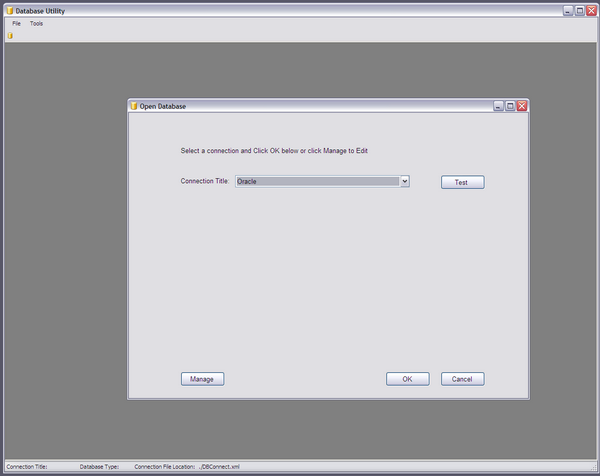Introduction
This application is intended to be integrated with an existing program, or become the shell of a new project that will utilize multiple database connections to Oracle and SQL Server database platforms.
Background
Many applications use a database as a backend source of data. In doing so, connecting to multiple databases is required, especially from a QA perspective. Customers also enjoy the ability to edit connections without having to edit XML or text configuration files due to the complexity of the files and lack of technical knowledge. I created this originally as a shell for a Data Generation utility for a software package I am testing. I ended up using an existing DAL that we had, so I shelved this. I decided that the effort I put into may save someone else time, so here it is.
Using the code
The code is straightforward in most areas, and is documented pretty well. I will say the XML / XPath portion is a little more complex. I want to thank Michael Chao as I used one of his programs from CodeProject as a starting base for editing the XML connection file. His article can be found here:
Here is a snippet for creating a new connection (string):
private void CreateConnectionInXML()
{
string FileNameNew = DataConnection.ConnectionFileLocation;
int dbtypenew;
if (comboBoxDBType.SelectedIndex == 0)
dbtypenew = 1;
else
dbtypenew = 2;
try
{
XmlTextReader reader = new XmlTextReader(FileNameNew);
XmlDocument docnew = new XmlDocument();
docnew.Load(reader);
reader.Close();
XmlNode currNode;
XmlDocumentFragment docFrag = docnew.CreateDocumentFragment();
docFrag.InnerXml = "<connection>" +
"<title>" + textBoxConnTitle.Text + "</title>" +
"<server>" + textBoxServerName.Text + "</server>" +
"<database>" + textBoxDatabaseName.Text + "</database>" +
"<dbtype>" + dbtypenew + "</dbtype>" +
"<username>" + textBoxUsername.Text + "</username>" +
"<password>" + textBoxPassword.Text + "</password>" +
"</connection>";
currNode = docnew.DocumentElement;
currNode.InsertAfter(docFrag, currNode.LastChild);
docnew.Save(FileNameNew);
this.DialogResult = DialogResult.OK;
}
catch (Exception ex)
{
MessageBox.Show("Exception: {0}", ex.ToString());
this.DialogResult = DialogResult.Cancel;
}
}
This program was written with Visual Studio 2008 for .NET 3.5. I am sure it could be modified to work with lower versions.
Here are some screenshots:
Main Form

Edit Form

Points of interest
I will say this is my very first coding project outside of school. I am still working on the main tool I am creating, and wish I could show it here, but cannot for business reasons. I hope this helps someone, and welcome any feedback as I am just getting started in the software development field.
History
